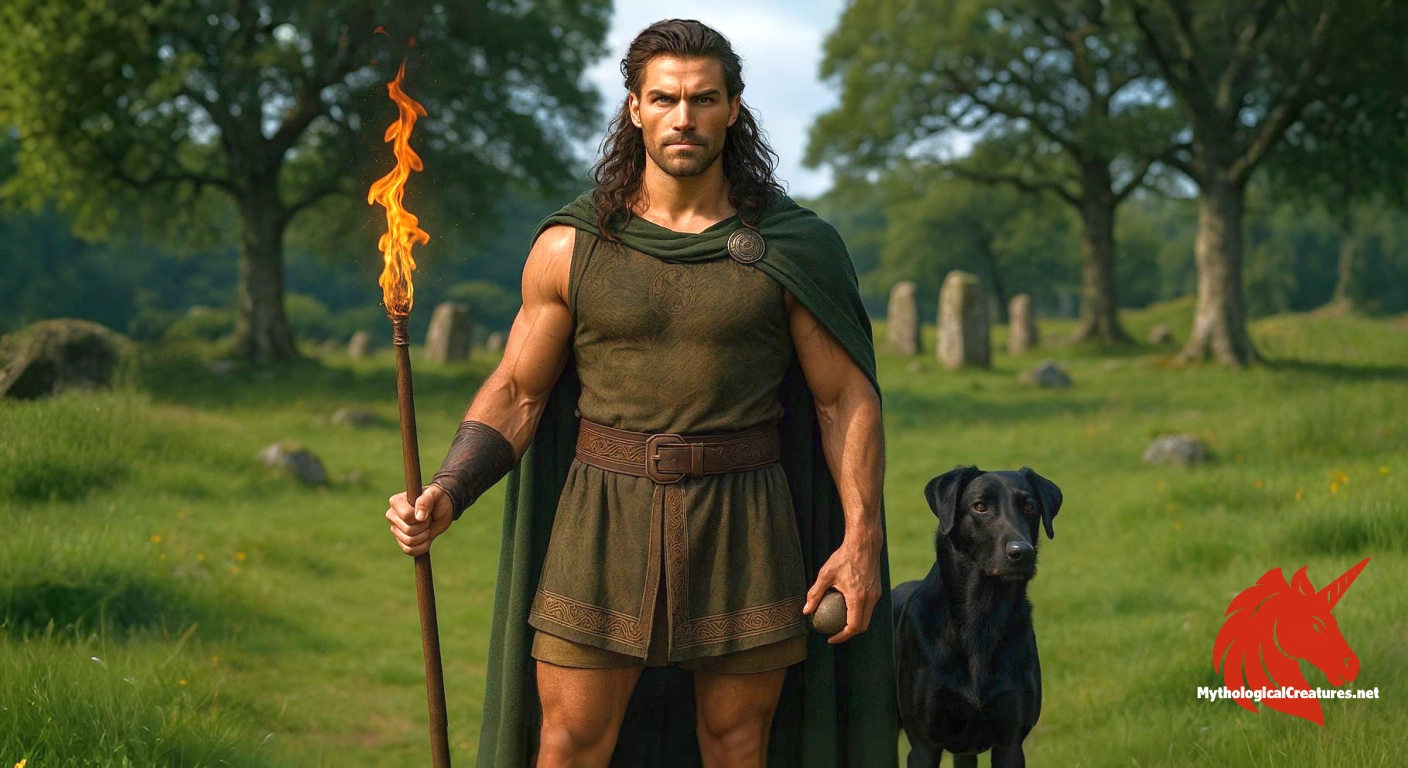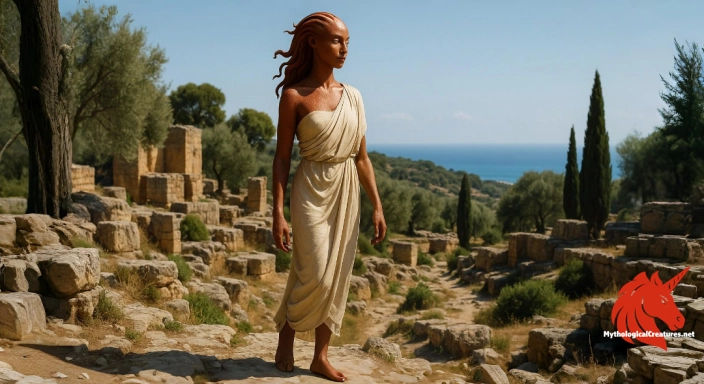Lugh: Lugh is a multifaceted deity in Irish mythology, celebrated as a warrior, king, and master craftsman.

Lugh
Lugh - Lugh is central to Irish lore, symbolising the synthesis of martial skill, creative genius and lawful authority, and his legacy continues to influence Irish cultural identity.
Origins & First Encounters
Lugh is one of the most eminent deities in Irish mythology, celebrated as a paragon of skill, kingship, and wisdom. He is intricately linked with the Tuatha Dé Danann, the ancient race of supernaturals who once shaped the mystical landscape of Ireland. Born of a divine and mortal blend through his parents Cian and Ethniu, his lineage weaves together both celestial and earthly elements. His early mythic attestations are richly rendered in narratives that emphasise honour, bravery, and the balanced marriage of art and warfare. The harvest festival of Lughnasadh, which bears his name, underscores the vital connection he holds with the rhythmic cycles of nature. Throughout the mythic tradition, his multiplicity of roles—from warrior to master craftsman—highlights the value placed on both physical might and intellectual prowess. The stories surrounding him also reflect societal ideals of rightful kingship and truthful leadership anchored in ancient Irish culture. His enduring legacy encapsulates the spirit of creativity and strategic brilliance that resonated with communities long past, making him a timeless figure in Celtic lore. Overall, Lugh embodies a dynamic blend of mortal vigour and divine influence that continues to inspire admiration and scholarly reflection.
Source Texts & Tale Variants
The rich tapestry of Lugh’s legend is drawn from a variety of ancient manuscripts and oral traditions that have been maintained over the centuries. Medieval texts such as the Lebor Gabála Érenn and the Metrical Dindshenchas provide detailed, though sometimes fragmentary, narratives of his exploits and divine interventions. Several accounts describe his decisive killing of the tyrant Balor during the Battle of Mag Tuired, a tale that has been recounted in myriad local and literary sources. Folklore preserved through generations further embellishes his persona, highlighting not only his martial triumphs but also his inventive contributions to art and craft. Variations in the stories reflect the oral tradition of early Ireland, where bards and storytellers adapted his character to suit changing cultural and political landscapes. Some accounts merge his identity with other heroic figures, thereby reinforcing his role as a saviour and exemplar of balanced virtue. The diversity of sources, ranging from ecclesiastical annals to secular narrative poems, illustrates the multifaceted nature of his legend. In essence, these varied storylines provide a composite portrait of a deity whose mystique has evolved through both written and spoken word, enriching our understanding of ancient Celtic society.
Form & Powers
Lugh is often depicted with a commanding presence that blends youthful radiance with the gravitas of a battle-hardened leader. Artists and chroniclers alike describe him as possessing striking features—a pair of keen, perceptive eyes and a stature that bespeaks both strength and agility. His physical form is rendered as robust and athletic, befitting the role of a warrior and master craftsman. The legendary epithet ‘Long Hand’ not only symbolises his far-reaching influence but also hints at an elongated, graceful physicality that is often celebrated in Celtic art. Some traditional portrayals suggest that his appearance carries an ethereal glow, reflective of his divine heritage and inner fire. His attire is frequently imagined as richly adorned with symbolic motifs that echo the natural world and the celestial, weaving together elements of both elegance and martial rigour. The artistic representations, whether carved in stone or spun through oral imagery, portray Lugh as a figure of balanced power—resplendent in both form and function. His ever-watchful eyes and measured posture have come to epitomise the ideal of a leader who is as much a thinker as he is a fighter. Variations in depictions across different eras underscore a subtle evolution in the artistic conceptualisation of his persona, further enriching the lore that surrounds him.
Regional Faces
Lugh’s mythology intricately weaves itself into the regional fabric of Celtic tradition, adapting distinct nuances as it traverses different cultural landscapes. In Ireland, he is revered as a multi-talented deity whose abilities in warfare, craft, and rulership have made him a central figure in both ancient lore and seasonal celebrations. Meanwhile, in Wales, his counterpart Lleu Llaw Gyffes shares many of his attributes, though the narratives surrounding him are imbued with local cultural symbolism and a more pronounced focus on fate and transformation. In parts of Scotland and the broader Gaelic world, echoes of Lugh’s legend mingle with native heroic traditions, often emphasising his resourcefulness and the sanctity of rightful authority. Throughout these regions, local festivals and rituals subtly integrate aspects of his myth, ensuring that his legacy remains alive in seasonal rites and community storytelling. The fluidity of his character has allowed communities to mould his narrative to reflect local values and environmental connections, from the agricultural rhythms of the land to the innate human desire for heroic exemplars. Folk art, traditional music, and ceremonial practices across these regions further highlight the adaptive and inclusive nature of his myth. This cross-cultural exchange not only reinforces his status as a unifying figure in Celtic lore but also demonstrates how regional interpretations can enrich and diversify the overarching narrative. Each local adaptation contributes to a broader understanding of Lugh, celebrating his enduring vitality and multifaceted legacy in the tapestry of Celtic mythology.
Cultural Parallels
The multifaceted nature of Lugh invites compelling comparisons with deities and legendary figures across various mythological traditions. His blend of martial prowess and artistic ingenuity finds echoes in the classical figures of both Apollo and Mercury, who similarly embody both creative brilliance and decisive action. While Apollo is often celebrated for his connection to music, prophecy, and sunlit inspiration, Lugh’s legacy is equally marked by his mastery over warfare, law, and crafts. The interpretatio romana, aligning Lugh with Mercury, further underscores a shared recognition of ingenuity, eloquence, and the swiftness of mind. In Welsh mythology, the striking parallels between Lugh and Lleu Llaw Gyffes offer an illustrative case of a shared cultural archetype that bridges regional delineations. Both figures serve as symbols of youthful vigour and tactical wisdom, though Lugh is often portrayed with a more pronounced regal authority. The thematic similarities extend to the realms of rightful kingship and the maintenance of cosmic order, where both figures are invoked as embodiments of justice and transformative power. Such comparative analyses reveal that while the narrative nuances may vary, the underlying archetype of a heroic, multi-talented leader is a recurring motif in European myth. The cross-cultural resonance of his character illustrates how ancient societies projected similar ideals of excellence and innovation onto their pantheons. Ultimately, Lugh stands as a testament to the universality of myth, bridging disparate cultures through shared symbols of human endeavour and divine insight.
Legacy & Modern Evolution
Over the centuries, Lugh’s myth has undergone a dynamic evolution, continually adapting to the shifting currents of cultural and artistic expression. In medieval manuscripts, he is portrayed with a dual edge of fierce combat prowess and an artist’s meticulous creativity, a portrayal that resonated deeply within an era steeped in both conflict and craftsmanship. The Celtic Revival of the 19th and 20th centuries breathed new life into his narrative, inspiring modern poets, novelists, and artists who recast him as an eternal symbol of innovation and rightful leadership. Contemporary celebrations of Lughnasadh rekindle his connection to the cycles of nature and community, affirming his status as a deity whose influence transcends historical boundaries. Modern reinterpretations often focus on his role as a unifier of diverse talents—a figure whose multifaceted abilities speak to the creative spirit in all of us. Lugh’s legacy also finds expression in popular culture, where his character is reimagined in literature, theatre, and even digital media, drawing a new generation into the rich tradition of Celtic mythology. His myth not only highlights the interplay between old and new but also serves as a poignant reminder of the enduring power of storytelling. As academic discourse and artistic endeavours continue to explore his layered persona, Lugh remains an emblem of transformation and intellectual vivacity. His enduring appeal lies in the way he encapsulates the heroic ideal—a beacon of artistic mastery, martial excellence, and the perpetual quest for justice in an ever-changing world. Today, Lugh’s legacy is a vibrant thread in the fabric of modern reinterpretations of Celtic myth, echoing timeless themes of balance, creativity, and noble authority.
Interesting Fact
An intriguing facet of Lugh's mythology is that his son, Cú Chulainn, is often seen as an incarnation of his own heroic spirit, linking generations of legendary valor in Irish lore.
Quick Creature Info
Associations:
Our Mythic Legendary Rating:

Also Sometimes Known As:
Habitat:
Supernatural Powers:
Physical Attributes:
Abilities:
Behavior:
Lore:
Related Creatures, Tales or Lore
- LLugus
- LLleu Llaw Gyffes
- MMercury
References
Discover Another Mythical Legend You May Not Have Heard Of?
Uncover the mysteries of ancient folklore and expand your knowledge of legendary beings from cultures around the world.
Dare to Meet the Pareia....
Mythical Disclaimer: The images and data on this site are derived from various historical and literary sources, but we have found that many myths often have multiple versions and interpretations across references, sometimes contradictory. As a result, these creature depictions are artistic interpretations—imaginative blends of folklore, legend, and a dash of AI guesswork. Because creature descriptions vary widely, our illustrations and accompanying information represent our best effort to honor mythology while bridging creative gaps. Enjoy these interpretations—just remember, we've done our best to respect the stories and validate available data, but in the realm of mythology, details often shift, imagination leads the way, and nothing is ever set in stone!
Curated by the Mythological Creatures Team (rev. May 2025)
